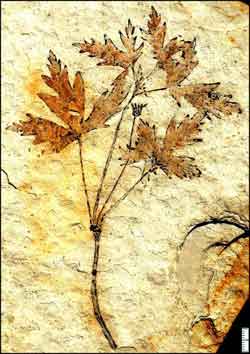Fossil is best look yet at an ancestor of buttercups

This 125 million-year-old fossil of a eudicot is the earliest, most complete to date. It was named Leefructus mirus by a group of scientists that includes IU Bloomington biologist David Dilcher. Credit: Zhiduan Chen<br>
“This fossil opens up a new way of thinking about the evolution of some of the first flowering plants,” said Indiana University Bloomington biologist David Dilcher, the Nature paper's American coauthor. “We are also beginning to understand that the explosive radiation of all flowering plants about 111 million years ago has had a long history that began with the slower diversification of many families of eudicots over 10, perhaps 15 million years earlier.”
An image of the fossil was selected as Nature's cover.
Dilcher and his Chinese colleagues Ge Sun and Hongshan Wang (Shenyang Normal University) and Zhiduan Chen (Chinese Academy of Sciences) named the fossilized plant Leefructus mirus in honor of Li Shiming, a non-scientist who donated the fossil to Ge Sun's new museum of paleontology in Liaoning Province, China. Ge Sun was the project's principal investigator.
The fossil shows the above-ground portion of a mature plant. A single stem leads to five leaves, and one leads to a fully developed flower. The entire fossil is about 16 cm (6.3 in) tall. Leaves are innervated by branching veins, and the small, cup-shaped flower has five petals.
“I think Leefructus had attractive flowers to advertise for pollinators to visit,” said Dilcher, when asked to speculate. “There were no bees at this time, so I think that flies, beetles or extinct types of moths or scorpion flies may have been involved in its pollination. Leefructus was found in the volcanic ash beds of an ancient lake. I think it was living near a lake, perhaps in a wet or marshy area much as buttercups do today.”
The scientists' analysis of the plant's form leads them to believe Leefructus should be placed among the Ranunculaceae, an old family of eudicots that includes buttercups and crowroot plants.
“When we look at the branching relationships of the tree for this group, the Ranunculaceae is at the end of several branches going to the other families, such as the poppies,” Dilcher said. “As a result, we believe that prior to 122 to 124 million years ago, several families of flowering plants had already begun to diverge. How much older the eudicots are we do not know yet, but this fossil suggests their origin certainly goes further back in the Cretaceous, perhaps even into the Jurassic.”
The profusion of flowering plant species in the second half of the Mesozoic Era, the age of dinosaurs, eventually led to flowers' domination of other types of plants in all but Earth's harshest climates. Evolutionary biologists believe the diversification of flowering plants also supported the radiation of a wide range of animal species, particularly pollinators and seed eaters, from beetles and bees to hummingbirds and bats.
Until now, most fossil information about the earliest eudicots has come from fossilized pollen, the plant equivalent of sperm. Despite pollen's small size, pollen grains have provided crucial information to paleontologists. But pollen can only tell scientists so much.
“What we know about the earliest eudicots comes from a few pollen records off the coast of West Africa and the lower Cretaceous sediments in southern England about 127 million years before present,” Dilcher said. “We can learn a lot from pollen, but the Leefructus fossil shows us that there is no substitute for a megafossil record if we are to understand the evolution of early flowering plants.”
The age of the Leefructus fossil was determined by analyzing the ages of surrounding rock via Argon 40/39 and Uranium-Lead dating methods.
This research was supported by grants from the Chinese Ministry of Education, the “111” Project, China's National Natural Science Foundation, and Shenyang Normal University.
To speak with Dilcher, please contact David Bricker, University Communications, at 812-856-9035 or brickerd@indiana.edu.
Media Contact
More Information:
http://www.indiana.eduAll latest news from the category: Earth Sciences
Earth Sciences (also referred to as Geosciences), which deals with basic issues surrounding our planet, plays a vital role in the area of energy and raw materials supply.
Earth Sciences comprises subjects such as geology, geography, geological informatics, paleontology, mineralogy, petrography, crystallography, geophysics, geodesy, glaciology, cartography, photogrammetry, meteorology and seismology, early-warning systems, earthquake research and polar research.
Newest articles

Properties of new materials for microchips
… can now be measured well. Reseachers of Delft University of Technology demonstrated measuring performance properties of ultrathin silicon membranes. Making ever smaller and more powerful chips requires new ultrathin…

Floating solar’s potential
… to support sustainable development by addressing climate, water, and energy goals holistically. A new study published this week in Nature Energy raises the potential for floating solar photovoltaics (FPV)…

Skyrmions move at record speeds
… a step towards the computing of the future. An international research team led by scientists from the CNRS1 has discovered that the magnetic nanobubbles2 known as skyrmions can be…




















